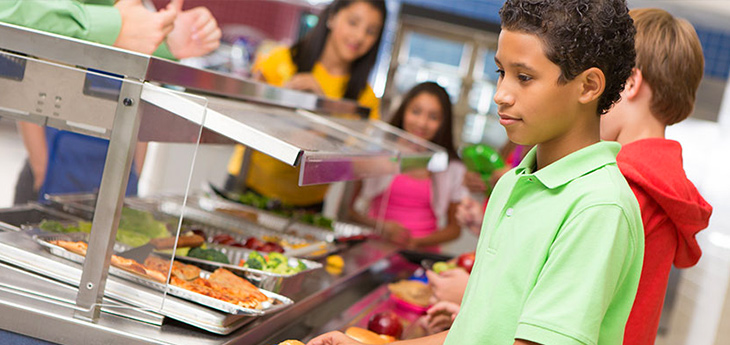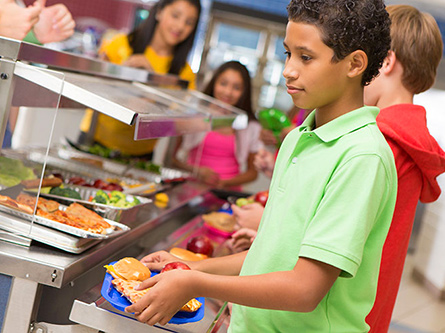
You may remember waiting in line at the school cafeteria for rubbery chicken nuggets or a soggy piece of pizza. Fast forward several years, and now you may be wondering what your children are eating at school.
Well, we may have some good news. But first, let's start with the importance of school lunches and teaching children healthy eating habits. UC Davis Health pediatricians Lena van der List and Dean Blumberg discuss these topics and more on the Kids Considered podcast.
Children and the effects of obesity
School food should appeal to children but should also be healthy and full of nutrients. Otherwise, food that is high in fat and calories helps contribute to the obesity problem in the U.S.
The percentage of children and adolescents affected by obesity has more than tripled since the 1970s. Nearly one-fifth of school-aged children have obesity.
Many factors contribute to obesity. These include genetics, metabolism, physical activity and consuming more calories than they need for growth and activity.
Children with obesity are at a higher risk for major health conditions like diabetes, asthma, heart disease and high blood pressure. They're also more likely to be bullied and teased by their peers, which can lead to social isolation, depression and lower self-esteem. In the longer term, a more obese child is more likely to be obese as an adult.
Explore our are for pediatric diabetes and endocrine disorders
How schools feed children
Meal planning for schools is a very complicated process. Menus need to cater to a wide range of tastes and restrictions, like peanut allergies. Schools also have a limited budget when it comes to feeding students.
Learn about food allergies in children and advice from pediatricians
So, that all means that school food needs to be lower cost and not require much preparation. This means foods are often higher in sugar, fat and salt.
There are about 55 million children and teens who attend public schools in the U.S. Kids eat between 35% and 50% of their daily calories at school. However, one-third of the calories consumed at school are unhealthy ones.
Foods eaten at school can be separated into three main categories:
- School meals like breakfasts, lunches and after-school snacks. These are sponsored by the U.S. Department of Agriculture and cost more than $17 billion each year.
- Food and drinks sold in vending machines. These often have higher fat contents and more empty calories.
- Outside foods brought in by students like snacks or lunches, or food brought in for birthdays and other events.
Sign up for our Health Highlights e-newsletter
What are the regulations on school lunches?
Let's take a look at the meals provided at schools. These programs support more than 30 million lunches and 15 million breakfasts per day for students in the U.S.
For children who suffer from food insecurity, this may be their biggest and most important meal of the day. Food insecurity is not having reliable access to enough nutritious and affordable food. More than 1 in 8 Americans suffer from food insecurity. This includes about 14 million children.
As for school meals, they're tied to guidelines for healthy eating. Many of these meals may not contain more than 10% from saturated fat. The guidelines try to include more fruits, veggies and grains, while aiming for more balanced menus. They also try to reduce fat content by serving more vegetable options and less beef, pork and fried foods.
The USDA says more than 90% of schools are serving meals that meet these higher nutritional standards. Children who eat meals at school have better nutrition than those that eat other meals.
Are there guidelines for vending machine drinks?
Current guidelines say that schools should only sell plain or carbonated water, low-fat milk, fat-free unflavored or flavored (chocolate) milk or milk alternatives. They can also sell 100% fruit juice or vegetable juice with no added sugar. However, fruit juices are not always healthy.
Find out if fruit juice is a healthy choice for you and your children
High schools can also sell calorie-free flavored and unflavored carbonated water or other calorie-free drinks, as well as lower-calorie beverages. Portions are limited to 8 oz. in elementary schools and 12 oz. in middle schools and high schools.
There are no portion size limits for plain water. High schools have additional options for lower-calorie and calorie-free beverages. These include up to 20 oz. portions of calorie-free flavored water and other flavored beverages (less than 5 calories per 8 oz. or less than 10 calories per 20 oz.).
Are there regulations on food brought in for parties, fundraisers, etc.?
Lastly, that third category of school food is those items brought into schools from homes. Most schools encourage healthier foods to be brought in. But this is controversial because some schools want to limit things like cupcakes and brownies altogether.
Banning sweets at school parties may seem a bit extreme. However, it forces parents to think about replacing unhealthy foods with healthier ones or little gifts, like pencils. This could also include candy bars or cookies that are often sold for school fundraisers.
When a school begins to set a standard for outside food, it changes the messages they're sending and how it impacts students. It begins to create a culture of healthy eating which can have lasting effects as children grow up.




